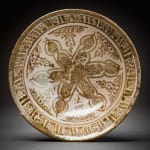Kashan Lustre Bowl, 1200 CE - 1300 CE
Fritware
6 x 2.5
AMD.16
Further images
Lustre, having been first used on glazed pottery in ninth century Iraq, became very popular between the tenth and twelfth centuries in Fatimid Egypt, and reached new heights in Seljuk...
Lustre, having been first used on glazed pottery in ninth century Iraq, became very popular between the tenth and twelfth centuries in Fatimid Egypt, and reached new heights in Seljuk Iran round about the thirteenth century, before the Mongol invasions.
Kashan was the centre of the lustre ware production of the region. It is there that Muslim potters developed a new finer material than clay known as “fritt”.
This bowl is a fine example of Kashan lustreware of the 12th century. It is of rounded form and of light brown colour.
The central motif dominates the entire decoration of the bowl. It consists of a fine symmetrical six-pointed star, with scroll motifs.
A perfectly detailed vegetal decoration surrounds the central motif. A calligraphic band on the inner rim of the vessel also decorates this piece.
This is a fine quality piece with a precise decoration pattern.
Kashan was the centre of the lustre ware production of the region. It is there that Muslim potters developed a new finer material than clay known as “fritt”.
This bowl is a fine example of Kashan lustreware of the 12th century. It is of rounded form and of light brown colour.
The central motif dominates the entire decoration of the bowl. It consists of a fine symmetrical six-pointed star, with scroll motifs.
A perfectly detailed vegetal decoration surrounds the central motif. A calligraphic band on the inner rim of the vessel also decorates this piece.
This is a fine quality piece with a precise decoration pattern.







